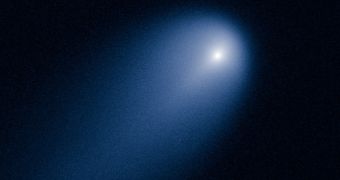Comet ISON (C/2012 S1) could very well be the comet of the century. We won't know for sure until it gets close enough to the sun, later this year. In the meantime, astronomers are eagerly awaiting its approach.
Unless they have the Hubble telescope at their disposal, in which case they can get a rather detailed view of the comet even now as it passes through Jupiter's orbit.
Hubble captured a few shots of the comet on April 10, when it was 621 million kilometers (386 million miles) from the sun or 634 million kilometers (394 million miles) from the Earth.
The comet is already close enough to leave a trail of gas and dust behind under the influence of the sun.
These initial images were used to determine that the nucleus of the comet is no larger than 4.8 to 6.5 kilometers (3 to 4 miles).
However, the head of the comet, the dust cloud surrounding it, is some 5,000 kilometers (3,100 miles wide. Its tail is a massive 92,000 kilometers (57,000 miles) long.
The comet nucleus' small size makes it hard to predict whether comet will shine bright in the night sky, it could be as bright as the full moon, or it will fizzle out as it comes within 1.2 million kilometers (730,000 miles) of the sun on November 28, 2013.

 14 DAY TRIAL //
14 DAY TRIAL //